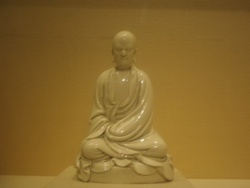Difference between revisions of "Tibetan Astro Science"
(Created page with " <poem> Tibetan “astro science” (as it is called) combines aspects of astronomical calculations and observations (such as calendars) with astrology, similar...") |
|||
| (3 intermediate revisions by 2 users not shown) | |||
| Line 1: | Line 1: | ||
| − | + | <nomobile>{{DisplayImages|1036|1755}}</nomobile> | |
| − | + | [[Tibetan]] “[[astro science]]” (as it is called) combines aspects of astronomical calculations and observations (such as calendars) with [[astrology]], similar to other [[ancient traditions]]. | |
| − | |||
| − | < | ||
| − | [[Tibetan]] | ||
In the [[Tibetan tradition]], the former is termed [[skar-rtsis]], and the [[latter]] [[byung-rtsis]]. | In the [[Tibetan tradition]], the former is termed [[skar-rtsis]], and the [[latter]] [[byung-rtsis]]. | ||
| Line 20: | Line 17: | ||
The text is divided into three chapters, focusing on: | The text is divided into three chapters, focusing on: | ||
| − | 1) The external [[universe]], its motions and cycles; | + | :1) The external [[universe]], its motions and cycles; |
| − | 2) The interactions of the [[human body]] and the [[cosmos]] (e.g. [[chakras]] and [[energy | + | :2) The interactions of the [[human body]] and the [[cosmos]] (e.g. [[chakras]] and [[energy channels]]); |
| − | 3) [[Meditative]] practices. | + | :3) [[Meditative]] practices. |
The [[Kalachakra cosmological model]] will be discussed in another section. | The [[Kalachakra cosmological model]] will be discussed in another section. | ||
| Line 28: | Line 25: | ||
For more [[information]], consult the following: | For more [[information]], consult the following: | ||
| − | http://www.berzinarchives.com/web/en/archives/study/tibetan_astrology_medicine/astrology/tibetan_astro_sciences/tibetan_astro_science_01.html | + | * http://www.berzinarchives.com/web/en/archives/study/tibetan_astrology_medicine/astrology/tibetan_astro_sciences/tibetan_astro_science_01.html |
| + | * http://www.men-tsee-khang.org/astrology/index.htm | ||
| + | * {{Nolinking|Gyatso, Khendrup Norsang (2004) Ornament of Stainless Light: An Exposition of the Kalachakra Tantra}}. Boston: [[Wisdom Publications]]. | ||
| − | http:// | + | {{R}} |
| + | [http://web.ccsu.edu/astronomy/tibetan_astro_science.htm web.ccsu.edu/astronomy] | ||
| − | |||
| − | |||
| − | |||
| − | |||
[[Category:Tibetan Cosmology]] | [[Category:Tibetan Cosmology]] | ||
[[Category:Tibetan Astrology]] | [[Category:Tibetan Astrology]] | ||
Latest revision as of 23:28, 26 October 2015
Tibetan “astro science” (as it is called) combines aspects of astronomical calculations and observations (such as calendars) with astrology, similar to other ancient traditions.
In the Tibetan tradition, the former is termed skar-rtsis, and the latter byung-rtsis.
Although heavily influenced by the neighboring traditions of India, Mongolia, and China, Tibetan astro science has unique aspects, among which is its complex relationship with traditional Tibetan medicine.
[Practitioners developed almanacs through detailed mathematical computations which combined astronomical and astrological aspects.
One result was an annual prediction of auspicious dates for farmers to plant and harvest their crops.
Of vital importance was the calculation of the nyadu tagpa, the forecast of the next year's climate and fortune, based on the position of the full moon of the tenth month of the Tibetan calendar (roughly November) in relation to Scorpius and the Pleiades.
An important basis for skar-rtsis is the Sri Kalachakra Tantra, a text first translated into Sanskrit in 1027 AD.
The text is divided into three chapters, focusing on:
- 1) The external universe, its motions and cycles;
- 2) The interactions of the human body and the cosmos (e.g. chakras and energy channels);
- 3) Meditative practices.
The Kalachakra cosmological model will be discussed in another section.
For more information, consult the following:
- http://www.berzinarchives.com/web/en/archives/study/tibetan_astrology_medicine/astrology/tibetan_astro_sciences/tibetan_astro_science_01.html
- http://www.men-tsee-khang.org/astrology/index.htm
- Gyatso, Khendrup Norsang (2004) Ornament of Stainless Light: An Exposition of the Kalachakra Tantra. Boston: Wisdom Publications.

